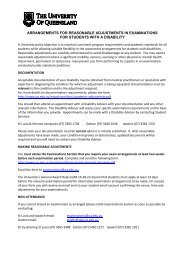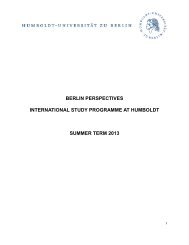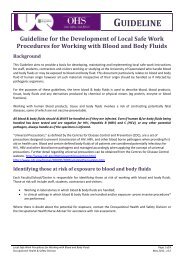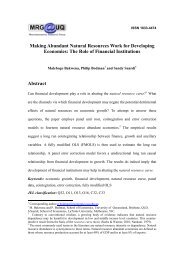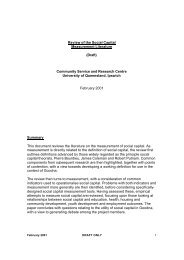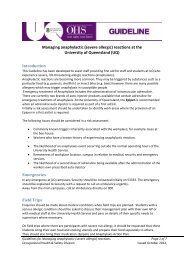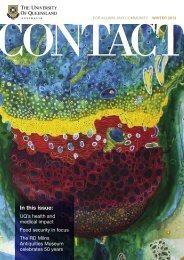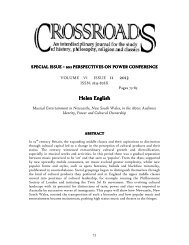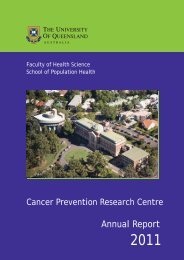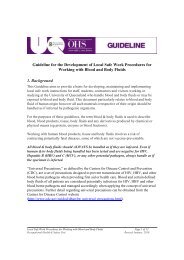Managing Traffic Incidents - University of Queensland
Managing Traffic Incidents - University of Queensland
Managing Traffic Incidents - University of Queensland
Create successful ePaper yourself
Turn your PDF publications into a flip-book with our unique Google optimized e-Paper software.
(Continued from page 17)<br />
The most significant activity <strong>of</strong> the entire<br />
SRMP development was the creation <strong>of</strong> the<br />
HDM-4 input file for the road network(s)<br />
using the Micros<strong>of</strong>t Access database management<br />
s<strong>of</strong>tware. Access was used to:<br />
– combine the road network data retrieved<br />
and uploaded from various sources;<br />
– create the Strategic Road Network Matrix<br />
by grouping, averaging and totalling collected<br />
information;<br />
– store and update adopted "constants"<br />
within the input file; and<br />
– format the input file ready for importing<br />
into HDM-4.<br />
Access also proved a valuable tool for making<br />
global or parameter-specific changes to<br />
the input file, as required.<br />
Calibration <strong>of</strong> most pavement deterioration<br />
pr<strong>of</strong>iles for various forms <strong>of</strong> damage could<br />
not be carried out due to a lack <strong>of</strong> reliable<br />
historic pavement data. In these cases<br />
HDM-4 default calibration factors were<br />
adopted. Some guidance on calibration<br />
parameters for Penetration Macadum pavements<br />
was provided in a road maintenance<br />
study undertaken by another consultant.<br />
The strategic analysis optimised the mix<br />
and timing <strong>of</strong> preventative, restoration,<br />
rehabilitation and reconstruction as well as<br />
defining the required budget and resourcing.<br />
It also identified the upgrading <strong>of</strong> all but the<br />
least trafficked <strong>of</strong> the unsealed roads in the<br />
National Highway Network on a total cost <strong>of</strong><br />
ownership basis.<br />
This project component highlighted a<br />
number <strong>of</strong> issues relating to the implementation<br />
<strong>of</strong> HDM-4 that may be <strong>of</strong> interest to any<br />
road agency:<br />
– Analysis <strong>of</strong> more than 1000 road sections<br />
at a time remains impractical (it is believed<br />
that the development team in<br />
Birmingham <strong>University</strong> will address this<br />
issue in Version 2 <strong>of</strong> the model);<br />
– Concrete deterioration model is strongly<br />
biased towards multi-lane freeways,<br />
where in Vietnam, jointed concrete pavements<br />
are primarily used for local roads;<br />
– Sustainability <strong>of</strong> HDM-4 as an investment<br />
planning tool is highly dependent on both<br />
data access and its co-ordination with<br />
other road management/planning tools<br />
used by the agency;<br />
– In its current form, significant IT capability<br />
is required to set-up and maintain the<br />
HDM-4 model; and<br />
– A comprehensive understanding <strong>of</strong> the<br />
sensitivities <strong>of</strong> the input data to the HDM-<br />
4 analysis outputs is the key to achieving<br />
the greatest benefit from the analysis.<br />
South Africa<br />
The South African National Roads Agency,<br />
(SANRA), are currently implementing<br />
HDM-4 across the national road network.<br />
The Agency has responsibility for managing,<br />
maintaining, financial planning, administration<br />
and law and road safety enforcement on<br />
the South African primary road network.<br />
For the implementation <strong>of</strong> HDM-4, the<br />
Agency has the advantage <strong>of</strong> having substantial<br />
historical research data, existing economic<br />
analysis models, and comprehensive<br />
road network data.<br />
The implementation <strong>of</strong> HDM-4 is being<br />
phased, with the initial phase consisting <strong>of</strong><br />
validating HDM-4 with the existing stand<br />
alone economic analysis tools used by the<br />
Agency. Once validated, HDM-4 will be<br />
used to undertake the economic analyses for<br />
strategic, programme and project analysis.<br />
The HDM-4 implementation program<br />
consists <strong>of</strong>:<br />
– Development <strong>of</strong> the strategic road network<br />
matrix, based on existing data<br />
contained in pavement management<br />
systems, strategic transportation planning<br />
tools, etc.<br />
– Validation <strong>of</strong> the HDM-4 pavement<br />
deterioration models by means <strong>of</strong> comparison<br />
with existing, calibrated, deterioration<br />
models used by the Agency.<br />
– Input <strong>of</strong> all economic and user cost data,<br />
obtained from existing economic analysis<br />
models. !<br />
HDM4 Website:<br />
http://hdm4.piarc.org/main/home-e.htm<br />
For further information, contact<br />
Gary Hayes and Brad Lawrence by e-mail:<br />
hayes_gary@bah.com & lawrence_brad@bah.com<br />
18 DECEMBER 2001


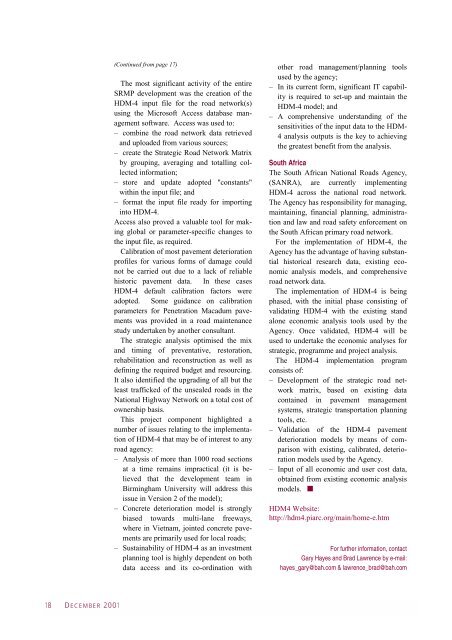

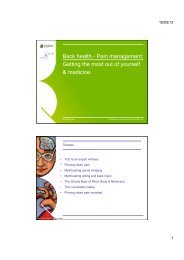
![Recycling [ PDF, 62KB ] - University of Queensland](https://img.yumpu.com/51805185/1/184x260/recycling-pdf-62kb-university-of-queensland.jpg?quality=85)
